

This graph resembles the graph of a sine function with an amplitude of approximately 2.2 and shifted approximately 60 degrees. The problem is then: Can you write the expression f(t) = sin(t) - 2 cos(t) so it is clear that this is an amplified and shifted sine function?
The necessary fact here is the trigonometric identity
sin(t-u) = sin(t) cos(u) - cos(t) sin(u) = cos(u) sin(t) - sin(u) cos(t).

|
Compairing this to the expression for f(t) we see that sin(u) is twice as large as cos(u), so in the right triangle with angle u degrees and adjacent side 1 unit long the opposite side must be 2 units long and thus, by Pythagoras Theorem the hypotenuse is sqrt(5). Thus sin(u) = 2/sqrt(5) and cos(u) = 1/sqrt(5). Hence |
f(t) = sin(t) - 2 cos(t)
= sqrt(5) (1/sqrt(5) sin(t) - 2/sqrt(5) cos(t))
= sqrt(5) (cos(u) sin(t) - sin(u) cos(t))
= sqrt(5) sin(t - u)
Problem: Can you write the expression f(t) = sin(t) - 2 cos(t) so it is clear that this is an amplified and shifted COSINE function?
To return to the previous page use your browser's back button.